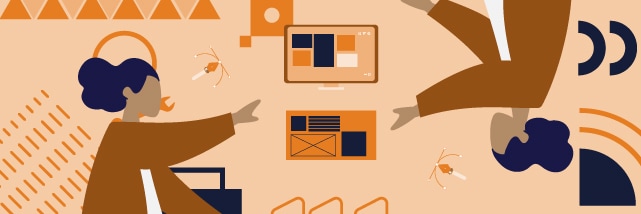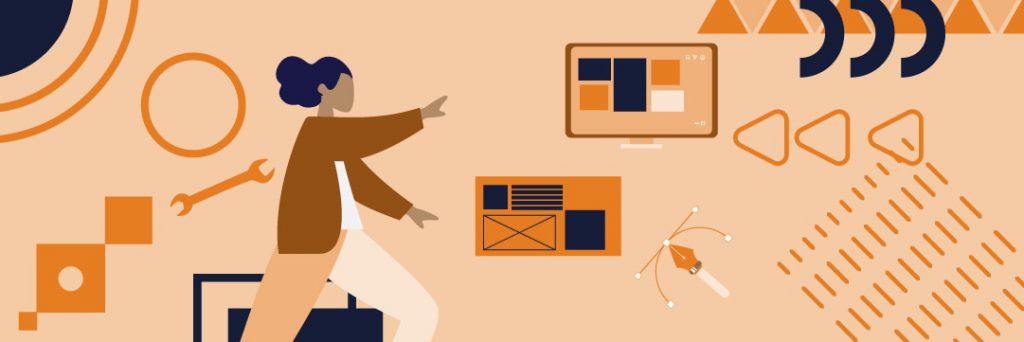Graphic design has some key elements, and composition is certainly one of them. While creating stand out design may seem natural to some, graphic design basics composition is that important piece where you can incorporate some long-standing tricks of the trade while at the same time using current trends – read on to find out more!
Graphic Design Basics Composition – What Exactly is It?
You’ve seen it. Two photos side by side of the same subject. But one is so-so and the other is stand-out-wow. What makes them different? Sure, it could be the light or maybe the smile, but more often than not, it’s the composition. Composition is vital to art, and that means everything from photos to graphic design. By learning and incorporating some techniques, your graphic design will stand out and shine and not be just so-so.
But, first, what does composition mean when you’re talking about graphic design?
We love this definition from GCF Global:
In short, it’s the way your content is arranged. It doesn’t matter if you’re working with text, images, or elements in a graphic; without a thoughtful, well-composed layout, your work would basically fall apart.
All these elements carry the design. They work together in a thoughtful manner and layout to enhance each other. The way you compose your piece is crucial to its success. You may also hear composition referred to as design or artwork. In composition, everything in the image falls under artwork, not just the “art.” This includes text, color, images, font, and graphics. It’s the whole shebang, and it has to work together. The great thing about composition is that it’s pretty easy to learn. Sure, having an artistic eye helps, but there are some basic rules to follow that will dramatically increase the aesthetic of your composition.
Basic Components of Composition
Professional graphic artists know the components of graphic design, and they know how to use them to make their art shine. You should be aware of these whether you are creating the graphic design yourself or hiring a pro to help you out. Remember, composition is where all of the individual elements of the design come together for a smooth, cohesive look. Think of it as your living room. You can have a gorgeous sofa, stunning art, a classic coffee table, and an exquisite chair. Each one may be fabulous on its own, but when you put them together, they clash and look like a mess of clutter. On the other hand, maybe each element isn’t knock your socks off fabulous, but when you put them together, the sparks fly and you have a cohesive flow. That’s what good composition does. So, let’s see how to get there!
Balance
Balance consists of asymmetrical and symmetrical balance, according to Canva, the graphic design platform. One is not better than the other; they both can be very successful as long as all the elements are, well, balanced. That means both sides of the design should have equal weight. Yes, even in an asymmetrical design. You can do this because all elements in the design have weight, even white space. 99designs shares this trick: Imagine an invisible set of scales in each design and make sure you don’t tip the scales by cloistering elements on one side of your grid.
A small block of text will have less weight than a large graphic, but heavy text will have more weight than thin, light text. A large, light photo may have the same weight as a bold but smaller image. Think about each element going into the design, from color to white space to photos to fonts. Each element adds weight, and therefore adds to the balance. Though the sides don’t have to be symmetrical, weight should be evenly dispersed in the design to achieve aesthetically pleasing balance.
The rule of thirds
Ahhh, one of our favorites. Whatever you are doing artistically, this has great effect. Check out what this tidbit says about the rule of thirds:
It’s a fundamental guideline that’s so simple and effective, it often feels like a cheat: divide your design into three rows and three columns. The points where the vertical and horizontal lines meet form natural guidelines for where you should place your subject and supporting elements.
Often people think a center focal point is the best thing, but if you offset that and balance with another element, you’re on the right track. Think of a photo of the ocean. If you place the sand in the bottom third, the sky in the top third, and the water in the middle, you’ll have a well-balanced photo every time, rather than just the sand and sea splitting the image in half. Again, remember balance with this. White space or a focal point of color can be one of the supporting elements.

The rule of odds
Sounds a bit like the rule of thirds, eh? It’s not so different as the rule of thirds divides our image into…thirds (three is an odd number, right?). Remember our ocean photo? It looks much better with three elements than two. That’s the rule of odds. Odd numbers look much more attractive together than evens. They offer a focal point (another element we are about to get to). Think about decorating your mantle. If you put a group of three or five candlesticks together, it’s going to look much better than two or four. It gives the eye a place to go and settle. That brings us to our focal point.
The focal point
This is the main point of your design. Whether it’s your logo or a visual ad or your social media post, have a focal point. This is one of the main points of graphic design’s basic composition. And yes, your focal point can be in the center, you’ll just use that rule of thirds with your supporting elements. And remember the rule of odds? You just want one focal point. Even with wedding photography, the couple is one focal point made of two elements. You can do the same with graphic design. Your focal point can be a word made of multiple letters. Just make sure you have something for the eye to rest on. Everything else is supporting, but nonetheless important.
The supporting elements
We keep mentioning the supporting elements, but what are they? These are the colors, the lines, the small components that enhance your graphic design composition. They create things like flow, cohesiveness, and rhythm through your design. You can use color to tie different elements together and the same font throughout to tie your text together. Don’t be afraid to play around because you may stumble upon something that looks fabulous by accident!
Hiring a Graphic Designer
Does all of this seem a bit overwhelming and it’s sending you on the search for a professional graphic designer to take over your project? That’s okay! You may want to hear this:
Every business owner needs a graphic designer who is well vast in the latest visual design trends. Mastery of graphic design basics and experience with various domains significantly contribute to the decision making process.
Graphic designers do this every day. The rule of thirds is second nature to them; that’s how they see the world! A graphic designer can not only help you out in a specific area, but they can also help build your brand identity. A good graphic designer should know current trends and what’s working now in the graphic design industry. They should have a handle on your field, too, and know what the tops trendsetters are doing. Often businesses update their brands; you’ve probably noticed that. That’s because trends change and you want a current graphic design. Your graphic designer can make sure you get it. So how do you find a graphic designer to work with?
Freelance or design firm
You may want to seek a freelancer where you can work closely and negotiate everything to your liking. You can get some great art and personal attention at lower costs sometimes through working with a freelancer. However, some people love working with a firm where you can have a team to work on your designs and make all the decisions. Another option is a design service like our own Bunny Studio. You have the best of both worlds here where you don’t have to negotiate prices or deadlines and you have everything is checked for quality. We know our professionals produce great work; you don’t have to worry about what you’ll get.
However you find your graphic designer, consider a few things before hiring:
- What type of experience do they have?
- Are they well versed in what you want?
- Do they have good reviews or recommendations from past clients?
- Will they meet your deadline and be within your budget?
The ultimate goal is having a great graphic design to bring your brand all together and attract your audience. What would be the icing on the cake is to find a designer who you enjoy working with and would like to continue with them when you need another design.
A Quick Recap of Graphic Design Basics Composition
Composition is an essential component in graphic design, bringing all of the design elements together in a cohesive, attractive, engaging way. The composition should reflect your brand and style and work with other branding elements. Sometimes it’s great to work on this on your own; if you do, follow the tips we offer. Other times it’s a much better idea to hire a graphic designer for your designs. They know the ins and outs of composition and can create a stunning design for you that will captivate your audience. Bunny Studio has dedicated, professional experts in this field who would love to create stunning designs with top-notch composition. Let us know if we can help! We’re just a hop away!










